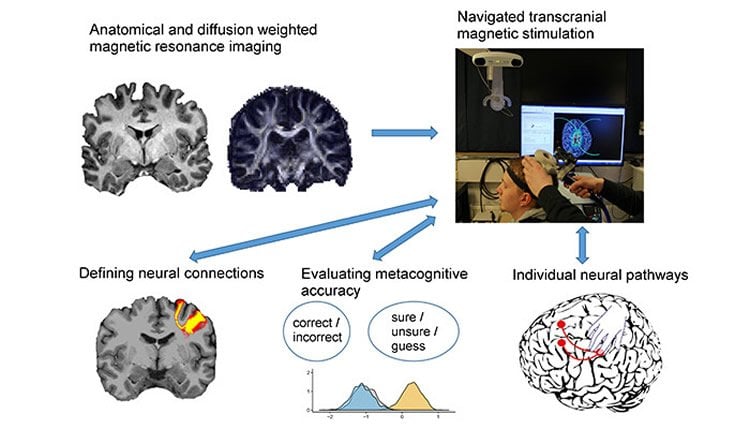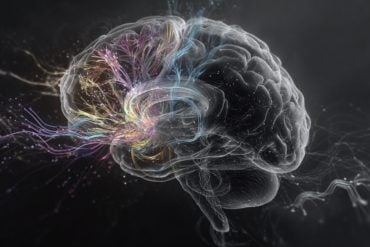Summary: A new study reports transcranial magnetic stimulation of the prefrontal cortex improves a person’s ability to evaluate their performance during a working memory task.
Source: Aalto University.
Researchers at Aalto University and the University of Helsinki have succeeded for the first time ever in affecting metacognition of a tactile working memory task by combining neural pathway imaging and magnetic stimulation of the brain.
By combining different brain research methods in a versatile manner the researchers showed for the first time that transcranial magnetic stimulation of the brain targeting the prefrontal cortex can improve a test subject’s ability to evaluate his or her performance in a tactile working memory task. The ability of human subjects to monitor and control their own cognitive processes is called metacognition.
Metacognition is important for people and in many neuropsychiatric illnesses, it is possible to recognize that it has weakened.
‘The patient’s reduced sense of being ill is familiar from conditions such as Alzheimer’s disease, schizophrenia, and traumatic brain injury. Understanding the brain function of healthy test subjects could help in the development of new treatment methods for neuropsychiatric illnesses in the future,’ says Doctoral Candidate Juha Gogulski.
Safe method
Transcranial magnetic stimulation refers to a method in which the nerve cells of the brain are activated from outside the skull with the help of a magnetic field. When used correctly the method is safe, and it is utilized in procedures such as pinpointing the location of the primary motor cortex or the speech area before brain surgery, and in the treatment of depression.
Taking part in the study as test subjects were 14 healthy volunteers. They first underwent structural magnetic resonance imaging (MRI) of the brain as well as a diffusion MRI that is sensitive to the movement of water molecules in the brain, making it possible to identify the direction of neural pathways. After the MRI, the neural pathway connections between the primary somatosensory cortex and the prefrontal cortex were determined for each individual.

In the last part of the study the test subjects completed working memory tasks in which they were asked to keep in mind the characteristics of touch sensations from the fingertip and to evaluate whether or not the touch stimulation that was just given was similar to or different from the previous stimulus. During the test they were given magnetic pulses to prefrontal cortex areas that had a neural pathway connection to the part of the somatosensory cortex representing the index finger. The test subjects also evaluated how certain they were about their answers, on which basis calculations were made on how well a person’s own evaluation corresponded to the actual performance level.
Magnetic stimulation of the prefrontal cortex improved the test subjects’ evaluation of their performance, as they were able to assess more accurately if their answers had been correct or incorrect.
The study was a collaboration between the Department of Neuroscience and Biomedical Engineering at Aalto University, and Department of Physiology in the Faculty of Medicine, University of Helsinki. The original article was published in the prestigious international science journal Cerebral Cortex.
Source: Juha Gogulski – Aalto University
Image Source: NeuroscienceNews.com image is credited to Juha Gogulski & Mikko Nyrhinen.
Original Research: Full open access research for “Neural Substrate for Metacognitive Accuracy of Tactile Working Memory” by Juha Gogulski, Rasmus Zetter, Mikko Nyrhinen, Antti Pertovaara, and Synnöve Carlson in Cerebral Cortex. Published online August 28 2017 doi:10.1093/cercor/bhx219
[cbtabs][cbtab title=”MLA”]Aalto University “Magnetic Stimulation Improves Awareness of Cognitive Abilities.” NeuroscienceNews. NeuroscienceNews, 3 September 2017.
<https://neurosciencenews.com/magnetic-stimulation-cognitive-ability-7405/>.[/cbtab][cbtab title=”APA”]Aalto University (2017, September 3). Magnetic Stimulation Improves Awareness of Cognitive Abilities. NeuroscienceNew. Retrieved September 3, 2017 from https://neurosciencenews.com/magnetic-stimulation-cognitive-ability-7405/[/cbtab][cbtab title=”Chicago”]Aalto University “Magnetic Stimulation Improves Awareness of Cognitive Abilities.” https://neurosciencenews.com/magnetic-stimulation-cognitive-ability-7405/ (accessed September 3, 2017).[/cbtab][/cbtabs]
Abstract
Neural Substrate for Metacognitive Accuracy of Tactile Working Memory
The human prefrontal cortex (PFC) has been shown to be important for metacognition, the capacity to monitor and control one’s own cognitive processes. Here we dissected the neural architecture of somatosensory metacognition using navigated single-pulse transcranial magnetic stimulation (TMS) to modulate tactile working memory (WM) processing. We asked subjects to perform tactile WM tasks and to give a confidence rating for their performance after each trial. We circumvented the challenge of interindividual variability in functional brain anatomy by applying TMS to two PFC areas that, according to tractography, were neurally connected with the primary somatosensory cortex (S1): one area in the superior frontal gyrus (SFG), another in the middle frontal gyrus (MFG). These two PFC locations and a control cortical area were stimulated during both spatial and temporal tactile WM tasks. We found that tractography-guided TMS of the SFG area selectively enhanced metacognitive accuracy of tactile temporal, but not spatial WM. Stimulation of the MFG area that was also neurally connected with the S1 had no such effect on metacognitive accuracy of either the temporal or spatial tactile WM. Our findings provide causal evidence that the PFC contains distinct neuroanatomical substrates for introspective accuracy of tactile WM.
“Neural Substrate for Metacognitive Accuracy of Tactile Working Memory” by Juha Gogulski, Rasmus Zetter, Mikko Nyrhinen, Antti Pertovaara, and Synnöve Carlson in Cerebral Cortex. Published online August 28 2017 doi:10.1093/cercor/bhx219






